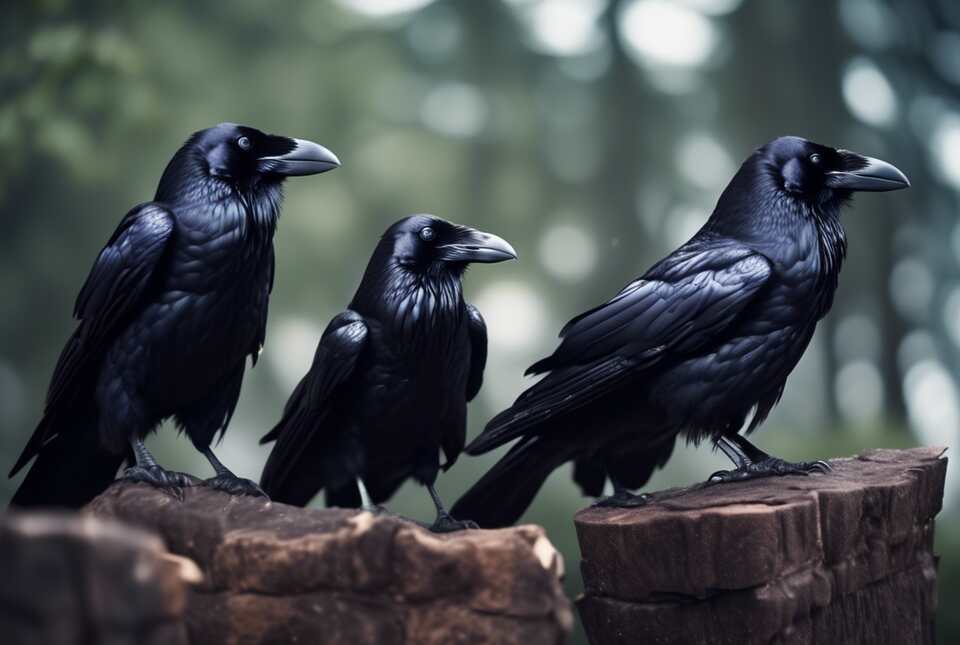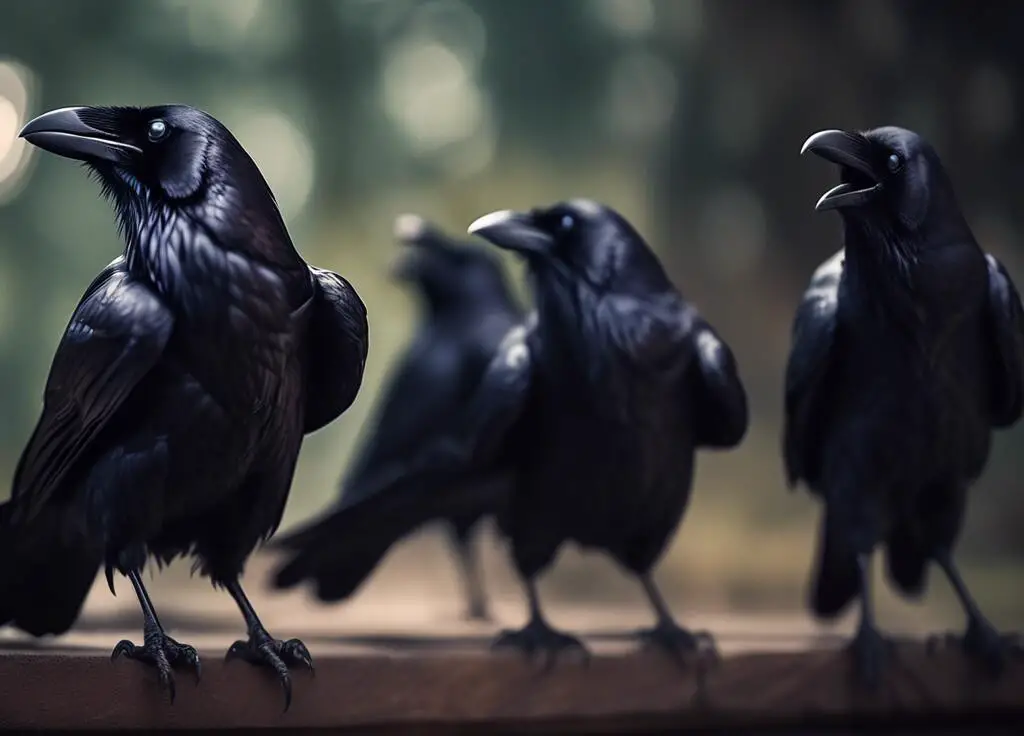Ravens have long been associated with mystery, intelligence, and a touch of eerie charm. Beyond their black plumage and haunting caws, these birds have a unique collective noun that adds to their enigmatic aura. A group of ravens is called an “unkindness.” This term may seem odd at first, but there are historical and cultural reasons that shed light on why ravens are labeled as such when they gather.
Table of Contents
The Origin and Significance of the Term “Unkindness” for a Group of Ravens
Historical Roots:
The term “unkindness” to refer to a group of ravens is believed to have originated from the Middle Ages in England. During this period, people were highly superstitious, and animals often carried symbolic meanings. Ravens, with their dark coloring and raucous calls, were viewed as creatures of the occult and were associated with death and darkness.
Significance and Symbolism:
The choice of the term “unkindness” to describe a collective of ravens carries a deeper symbolism beyond just the birds’ appearance. Ravens are highly intelligent birds known for their complex social structures and behaviors. They are often seen as harbingers of change or transformation in different cultures and mythologies worldwide.
Cultural Interpretations:
In various mythologies and folklore, ravens are commonly depicted as messengers or companions of gods and deities. For example, in Norse mythology, Odin, the chief of the Norse gods, was accompanied by two ravens named Huginn (thought) and Muninn (memory), who flew across the world and brought back information to him.
Collective Behavior:
The term “unkindness” may also reflect the behavior of ravens when they gather in large numbers. Ravens are known to be highly territorial and can display aggressive tendencies, especially during the breeding season. When multiple ravens converge in one area, they may exhibit behaviors that appear unkind or hostile towards each other and other animals.
During the 19th century, people believed that ravens weren’t the kindest of parents and would often make their chicks leave the nest before they were ready to fledge. This misconception likely contributed to the term “unkindness” being applied to a group of ravens, reflecting a misunderstanding of their parenting behavior rather than their collective behavior.
Evolution of Language:
Language is a living entity that evolves over time, and terms like “unkindness” for a group of ravens showcase how words can carry historical and cultural significance. While the term may seem unusual in the modern context, it serves as a reminder of humanity’s deep-rooted connection to nature and the symbolic meanings we attach to the creatures that share our world.
The term “unkindness” for a group of ravens is a fascinating linguistic relic that captures the mystique and symbolism surrounding these enigmatic birds. From their historical associations with superstition to their symbolic significance in various cultures, ravens continue to intrigue and inspire awe. Next time you see a group of ravens in the sky, remember the intricate tapestry of language and meaning that accompanies these intelligent creatures.

Folklore and Symbolism Surrounding Ravens in Various Cultures
Ravens have long been revered in various cultures across the world for their intelligence, mystery, and symbolic significance. Let’s dive into the rich tapestry of folklore and symbolism surrounding these enigmatic birds.
The Raven in Norse Mythology: Odin’s Messenger
In Norse mythology, ravens hold a special place as the companions of Odin, the Allfather. Huginn and Muninn, named Thought and Memory, are two ravens that fly across the world and bring information to Odin. They symbolize wisdom, knowledge, and the unseen.
Native American Beliefs: Raven as a Trickster
Among Native American tribes, the raven is often portrayed as a trickster figure. In some folklore, the raven is a creator god who brought light into the world or stole fire to give to humans. The raven’s black plumage is associated with the void or the unknown and is seen as a potent symbol of transformation.
Celtic Mythology: Ravens as Otherworldly Guides
In Celtic lore, ravens are linked to the otherworld and are seen as oracles or guides between realms. The goddess Morrigan is often depicted in the company of ravens, signifying prophecy, protection, and the cycle of life, death, and rebirth. Their presence is believed to herald significant change or transformation.
East Asian Symbolism: Ravens in Chinese and Japanese Culture
In Chinese and Japanese tradition, the raven is a symbol of good luck and divine messengers. In Chinese mythology, the three-legged raven, known as the Sun Crow, is a solar symbol representing power and illumination. In Japanese folklore, the raven is associated with the Shinto sun goddess Amaterasu and is revered as a symbol of protection and guidance.
Modern Interpretations: Ravens in Literature and Pop Culture
Ravens continue to captivate the modern imagination and have found their way into literature, art, and popular culture. From Edgar Allan Poe’s iconic poem “The Raven” to the television series “Game of Thrones,” where the three-eyed raven possesses mystical powers, these birds evoke a sense of foreboding, wisdom, and enigma.
The folklore and symbolism surrounding ravens are as diverse and complex as the cultures that venerate them. Whether as messengers of the gods, trickster figures, or guides between worlds, ravens continue to intrigue and inspire with their mystical allure and timeless presence in human consciousness.
Conclusion
In exploring the origin and significance of the term “unkindness” for a group of ravens, we have delved into the rich tapestry of folklore and symbolism surrounding these mystical birds in various cultures. The designation of an “unkindness” of ravens encapsulates the enigmatic nature of these creatures and the deep-rooted associations they have held throughout history. The collective noun not only speaks to the mysterious and sometimes foreboding presence of ravens but also hints at the reverence and fear they have inspired in human societies over the centuries.
Ravens have long captured the human imagination, symbolizing a myriad of concepts ranging from death and darkness to wisdom and prophecy. In Norse mythology, Odin, the chief of the gods, was accompanied by two ravens, Huginn and Muninn, who served as his trusted messengers and sources of knowledge. These clever birds were believed to fly across the world each day, bringing back information to the All-Father. Their presence signified wisdom, thought, and the power of communication.
Similarly, in Celtic folklore, ravens were associated with the goddess of war and death, the Morrigan. Often depicted as a shape-shifter who could transform into a raven, the Morrigan was a symbol of battle, fate, and the cycles of life and death. The presence of ravens on the battlefield was seen as an omen of imminent death, yet also a reassurance of the goddess’s protection over the fallen warriors. Ravens thus embodied the dualities of life and death, light and shadow, in Celtic beliefs.
Across cultures, ravens have been both revered and feared for their intelligence, adaptability, and mysterious nature. In Native American traditions, the raven is often seen as a trickster figure, a cunning and resourceful being who challenges the status quo and brings about change and transformation. Among the Inuit people of the Arctic, the raven is a symbol of creation and is credited with bringing light to the world by stealing the sun and placing it in the sky.
The term “unkindness” for a group of ravens not only reflects the collective mystery and intrigue that surrounds these birds but also pays homage to the deep cultural and symbolic significance they hold in human consciousness. From ancient mythologies to modern literature, ravens continue to captivate our imagination and remind us of the interconnectedness of the natural world and the human psyche.
As we ponder the unkindness of ravens soaring across the sky, let us be reminded of the enduring power and mystique of these enigmatic creatures, bridging the realms of the mundane and the magical in ways that only they can.



